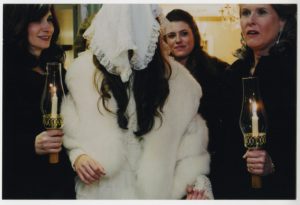Something Borrowed, an exhibit of over 50 wedding photographs, illustrates the importance of the nuptial ceremony in Jewish culture.
The photos, the earliest of which dates from 1890, are from the collection of the Ontario Jewish Archives, Blankenstein Family Heritage Centre (OJA) and are on display at the Miles Nadal Jewish Community Centre until Aug.29.
Each photograph highlights the rich traditions surrounding Jewish wedding rituals. The display delves into the history of the growing Jewish community in Canada and visually tells the narrative of how the roots of Jewish life manifested in this country since the early 20th century.
“It’s an interesting mosaic of a community,” Faye Blum, the curator of the exhibit and OJA assistant archivist, said.
The fashion, hairstyles, and traditions speak to the social trends in each time period. In one instance, Blum discovered that Annie Fisher and Morris Fiber, a couple in a wedding portrait she was examining from 1932, rented a tux and bridal gown to take wedding portraits, but never had a ceremony.

“No reception, no guests – penniless, my grandparents saved enough money to rent a wedding gown and tuxedo to have a portrait to mark their union,” Risa Epstein, the couple’s granddaughter told the OJA.
The couple had recently immigrated to Montreal from Romania and Russia respectively. The story behind the photograph represents the difficulty, especially economically, for recent immigrants at the time.
“One of the most interesting things is the demographic and geographic shifts of the communities…from living downtown and having weddings taking place in peoples homes [and] as the community establishes they move up the Bathurst Street corridor and have weddings in larger shuls,” Dara Solomon, the executive director of the OJA, said. “You can actually track those changes in the photographs.”
READ: INTERFAITH CAMP TEACHES KIDS ABOUT OTHER RELIGIONS
Blum wanted to explore how Jewish institutions brought couples together. For Rina Smith and George Fleischmann, their shared value of Zionism drew them to one another. In 1950, Smith introduced herself to Fleischmann at a Zionist group program at Christie Pits. One year later, the couple was married and made aliyah.
“We have been together ever since,” Smith said.
The Yiddish word bashert, a predestined soulmate, seems appropriate when looking at photos of William Harris and Tillie Shayne. In their photograph, the two lovers are kissing on a Toronto park bench. In 1914, Harris wrote on his University of Toronto graduation photo, “May the next picture I take in my life be with her as my wife.” In 1918, they were married in Montreal.
“The Jewish archives provide rich evidence of Jewish life in Ontario and the subject of weddings helps to demonstrate things that have remained consistent across time,” Blum said.

The most recent photograph in the exhibit is from Lea New and Avi Minkowitz’s wedding in 2012. Their wedding was deeply rooted in Chabad Lubavitch traditions. The couple got married under the night sky to symbolize God’s promise to Abraham that his children would be “as numerous as the stars” and during the ceremony, the groom’s buttons and shoelaces were undone to represent his boundlessness.
“In Chabad everything has a lot of mystic importance, so these symbolic things help to get into the seriousness of the wedding…those kind of traditions allow for mindfulness,” Lea New (now New Minkowitz) said.
